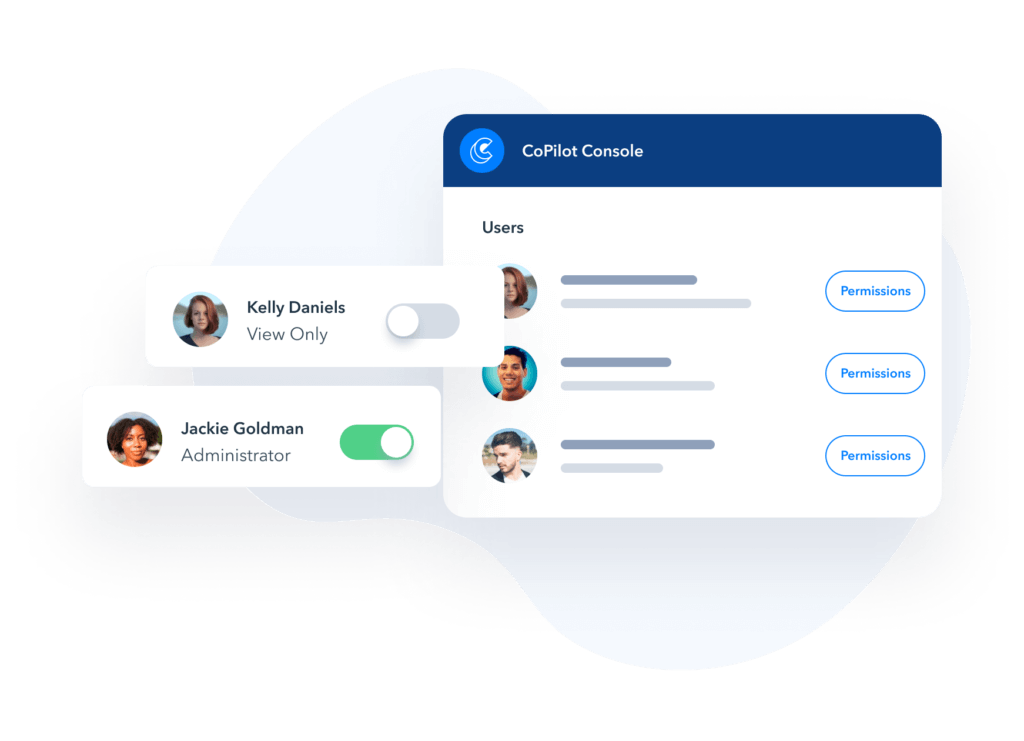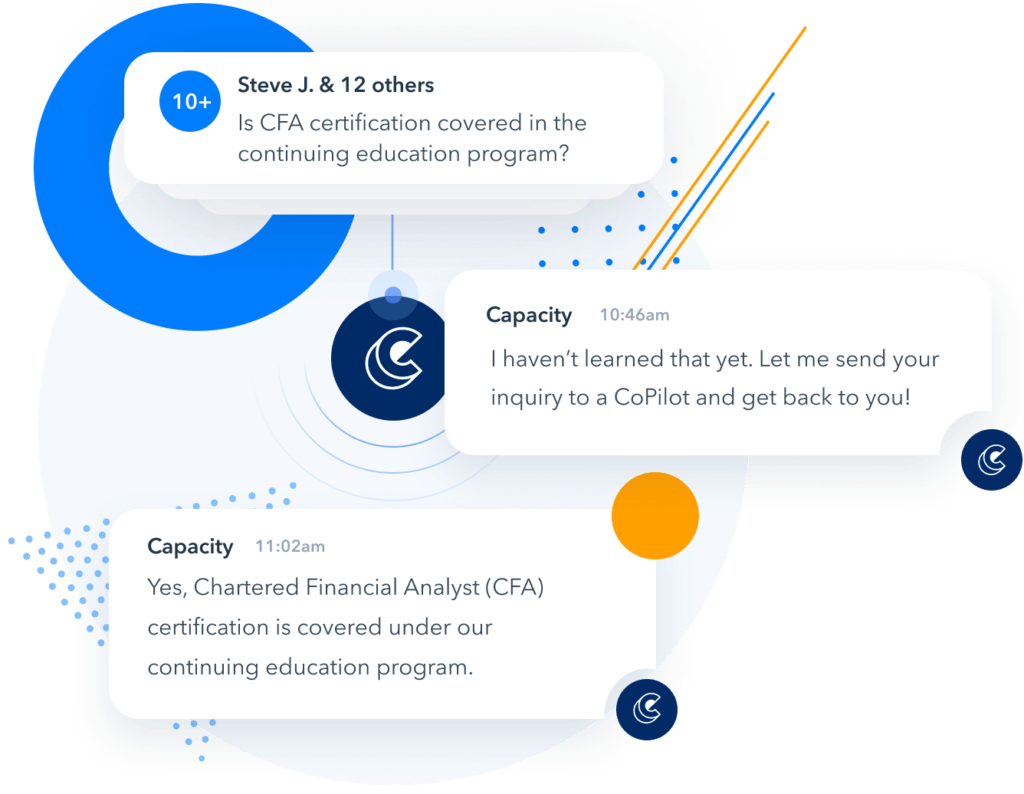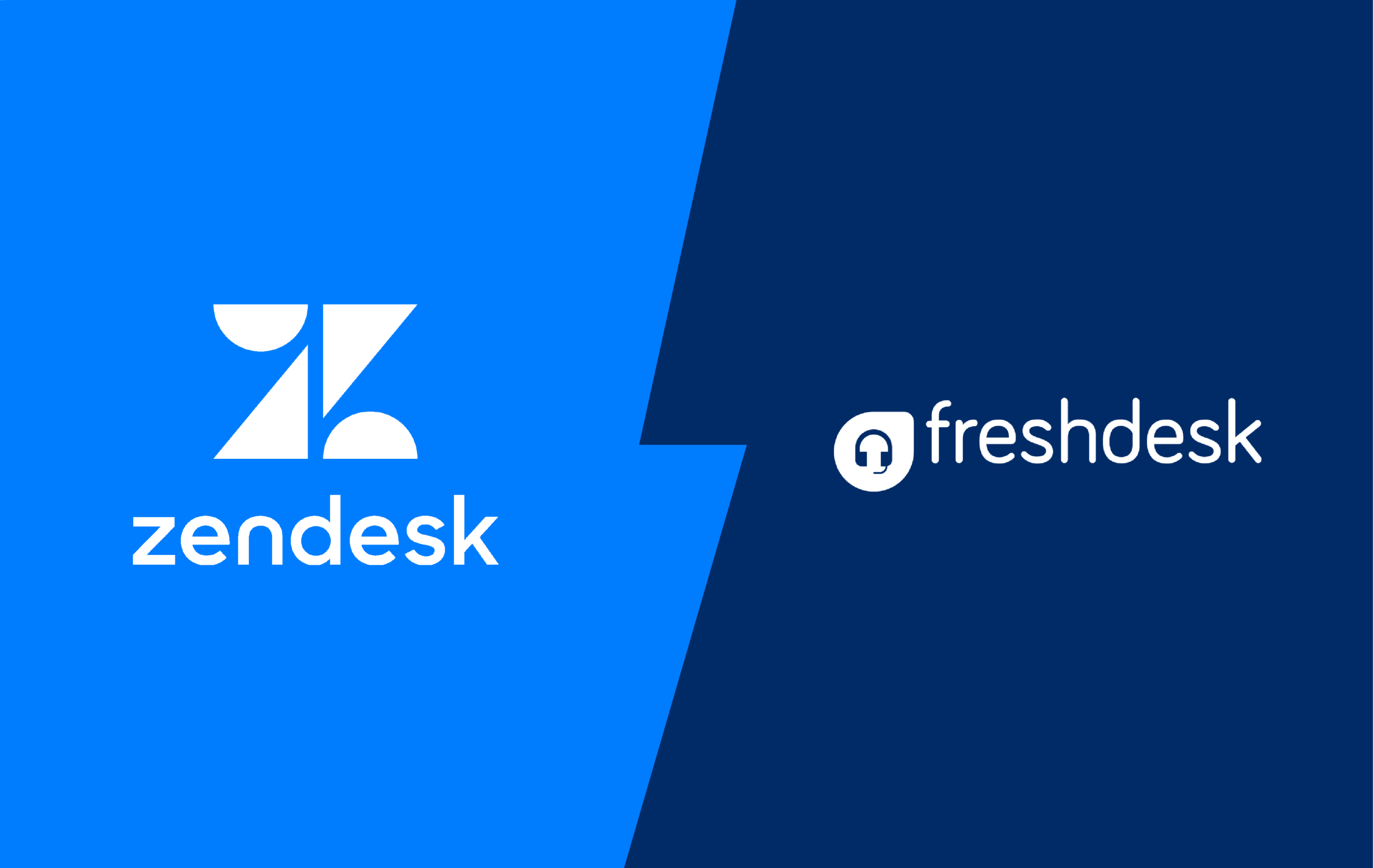Many businesses wonder, what are the differences between Freshdesk vs Zendesk? As the market has grown for helpdesk tools powered by artificial intelligence (AI) and machine learning (ML), customer and employee expectations for support-on-demand have responded in kind. In 2024 and beyond, there’s no room for an average support experience.
Freshdesk and Zendesk are two of the biggest players in the helpdesk software space. Both platforms offer a wide array of features that are constantly evolving. In this Freshdesk vs Zendesk review, learn more about these software solutions and which program best suits your business requirements.
Quick Summary
While both solutions boast affordable features and quick deployment, Freshdesk looks to be better suited for smaller teams in the SMB space, while Zendesk targets enterprise-class operations.
Where Freshdesk’s suite of software solutions for marketing, sales, support, and more make it easy for employees wearing multiple hats to keep tabs on everything, Zendesk’s robust selection of application integrations and powerful data collection makes complex processes easier to optimize for enterprise-level organizations.
Now, without further ado, here are the benefits of Freshdesk vs Zendesk.
Freshdesk vs. Zendesk: Knowledge base management.
Zendesk features.
Zendesk’s knowledge base management system combines stored institutional and tacit knowledge (via live agents). As support team members answer questions, Zendesk converts their responses into articles, otherwise known as exchanges. Once an agent saves a response as an article, Zendesk’s AI can automatically deliver the information to users who ask similar questions in the future.
Beyond live support, Zendesk’s knowledge base also features a chatbot called Answer Bot. As one would expect, Answer Bot can handle Level 0 tickets like FAQs.
- Pros: Its guide offers customization options and enterprise-friendly pricing.
- Cons: Some users find the need for customization overwhelming because it leaves too much work for the end-user.
Freshdesk features.
Freshdesk’s helpdesk system also features knowledge base management functionality. The process for adding knowledge within Freshdesk is slightly more labor-intensive than other options on the market.
Agents can write and manually sort solution articles for common inquiries, which can then be made available via the auto-suggest feature. Not to be confused with a chatbot, auto-suggest simply allows users to select a related solution article before submitting a ticket.
- Pros: Its solution articles allow agents to create evergreen content around FAQs.
- Cons: Ticket deflection isn’t a priority — most knowledge base inquiries will likely require human intervention.
Document mining.
Zendesk.
Zendesk recommends what it perceives to be related documents for agents and users to read on their own when they have a question.
- Pros: You can add existing knowledge held within Google Documents to the knowledge base.
- Cons: Functionality is limited — support agents and users need to scan recommended documents for the information they need.
Freshdesk.
For teams looking to import existing knowledge into their helpdesk, Freshdesk requires you to contact its support team via email and assist with a manual CSV upload.
Once knowledge has been imported to Freshdesk’s knowledge base, the documents aren’t automatically provided to users. Agents must manually turn on the article suggestion feature for any kind of automation to occur. However, the end-user must still search the documents themselves for the desired information.
- Pros: You can add existing knowledge to the helpdesk via a CSV import.
- Cons: Freshdesk is far more labor-intensive than Zendesk, and it still requires the end-user to dig for the information they need.
How Capacity can help with document mining.
Unlike Freshdesk vs Zendesk, support automation platforms like Capacity feature intelligent document processing (IDP) functionalities that turn your team’s documents into dynamic conversations. Once a document is uploaded to the cloud drive, Capacity begins adding the information to your question-and-answer exchanges for internal and external users.
Through chat, Capacity delivers helpful knowledge to customers and teammates, pulled directly from your uploaded docs. Not only does this eliminate unnecessary tickets for your support team but dramatically improves the end-user experience. Want to limit access to certain info? Capacity is equipped with a permission structure that makes security intuitive by automatically adjusting employees’ clearance based on their profiles in existing apps.

App integrations.
Zendesk.
Zendesk’s App Marketplace allows a wide range of disparate software applications to connect to its helpdesk tools. From CRM programs to email marketing platforms and more, App Marketplace appears to be a robust ecosystem for businesses concerned with system integration.
- Pros: Dozens of popular apps are available within the App Marketplace, making helpdesk deployment easier for most organizations.
- Cons: Custom API development doesn’t appear quite as simple. Since Zendesk lacks a developer portal, connecting software that isn’t listed in the App Marketplace could be labor-intensive.
Freshdesk.
Similarly, Freshdesk has also invested heavily in application integration with regard to its helpdesk solutions. Called the App Gallery, Freshdesk’s selection of easily integrated programs rivals Zendesk.
However, Freshdesk has thoughtfully built out a developer portal, encouraging customers to bring unlisted systems into the fold via SDK and API docs, and more.
- Pros: Between existing programs and a robust developer portal, Freshdesk isn’t leaving many software programs out in the cold with regard to integration.
- Cons: Information is the name of the game, not automation. In keeping with the theme of empowered support agents, Freshdesk’s connected apps don’t appear to be searchable by any kind of AI bot. This leaves users to retrieve and decipher information manually.
Integrations seem to be high priorities for both Freshdesk vs Zendesk.
Self-service portal.
Zendesk.
Zendesk’s aptly named Customer Portal Software serves as a hub for users to monitor and track their support tickets. Additionally, customers can use the portal to create new tickets by using predefined fields to help narrow down the purpose of their requests.
For internal teams, Customer Portal Software offers a bit more transparency between users, allowing teammates to review each other’s questions. Ideally, this prevents submitting multiple requests to the support team.
- Pros: Customer Portal Software helps customers stay informed on ticket status, track content updates, and more from a single touchpoint.
- Cons: Despite being positioned as a self-service portal, the emphasis with this tool is on connecting support teams and customers, not empowering customers to find their own answers.
Freshdesk.
Alternatively, Freshdesk’s self-service portal does the title a bit more justice, emphasizing a combination of answer bots, articles, forums, and ticket creation. Though the path from Level 0 support to speaking with an agent isn’t well defined, Freshdesk does seem to leverage more self-service options than its competitor.
It’s worth noting that the forum structure may be a bit odd to younger users as that communication medium has all but died in the wake of social media.
- Pros: More options for users to find their own answers without submitting a ticket and waiting for support.
- Cons: If a bot can’t immediately locate the relevant information in the knowledge base, the process becomes very manual. Users will need to search for documents and forum posts from past tickets to avoid submitting a ticket.
How Capacity can help with self-service.
Pioneering a new level of self-service, support automation platforms like Capacity empower teams and customers to find their own answers with the help of chatbots, generative AI and natural language understanding. With machine learning technology, users can submit questions using their natural dialect with a chatbot that is constantly learning. Through NLP, Capacity understands the intent and context of your words and mines apps, docs, and knowledge base for instant answers.

Better still, Capacity features guided conversation technology that helps users find the knowledge they might not have thought to ask for – rivaling both Freshdesk vs Zendesk features.
Ticket escalation process.
Zendesk.
Somewhat buried within Zendesk’s helpdesk ecosystem, Escalation Triggers are a series of rules support teams can customize to determine when a ticket is escalated from Level 0 (automated) to Level 1 (human intervention). Though seemingly more user-friendly than Freshdesk’s Supervisor system, escalation triggers may require some trial-and-error upon deployment.
- Pros: Ticket escalation and alerts can be modified to suit the needs of the business, resulting in better ticket management.
- Cons: Initial setup will likely require some testing, which can be frustrating for customers and support teams alike.
Freshdesk.
Using a tool called Supervisor, Freshdesk’s helpdesk system allows its customers to set up ticket reminders and escalations through a series of if-this-then-that (IFTTT) selections. Once set, tickets will be escalated from Level 0 to Level 1 with agent reminders according to the predetermined criteria.
- Pros: Dozens of adjustable criteria allow companies to customize ticket escalation as they see fit.
- Cons: The IFTTT structure means setting up alerts and escalation patterns could feel pretty intimidating for anyone not well-versed in helpdesk software.
How Capacity can help with ticket escalation.
Through the seamless integration of several AI-based technologies, Capacity makes ticket alerts and escalation intuitive for both parties. When an inquiry can’t be satisfied via your knowledge base, Capacity will route the conversation instantly to the dedicated team in charge.When a question calls for an in-depth response, Capacity’s expert finder technology reroutes the conversation through a dynamic knowledge graph to an internal SME who can help. Capacity’s ticketing system can let you respond to queries quickly, help you meet SLA requirements, and improve customer satisfaction.

Multi-channel communication.
Zendesk.
Zendesk has made it a point to leave no communication channel untouched — and it shows. In addition to typical helpdesk options like mobile chat support, web chat, email, Facebook, and Twitter, Zendesk supports SMS text, application integrations for Slack and Microsoft Teams, and unlisted systems via a mobile SDK and API.
- Pros: Zendesk offers robust support across a range of communication platforms for customers and service teams alike, making it a good choice for customer support software.
- Cons: Certain application integrations are only available in higher-priced plans — so it’s important to do your homework before committing.
Freshdesk.
Surprisingly, Freshdesk’s ability to integrate into multiple channels is somewhat limited. Beyond the typical integrations of email, chat (web-based and mobile), and Facebook, workplace systems aren’t quite so seamless.
Microsoft Teams, for example, can only be integrated with Freshdesk’s top four helpdesk plans, and even then, it only pings agents with notifications from the helpdesk.
- Pros: Freshdesk delivers seamless communication within the usual customer-facing channels for both small businesses and larger companies
- Cons: Communication with the helpdesk through popular workplace messaging systems is somewhat limited.
How Capacity can help with multi-channel communication.
From chat portals embedded in your site and mobile app to Slack and Microsoft Teams, Capacity empowers support teams with communication and automation. While other helpdesk solutions connect messaging systems, Capacity can take action on behalf of service pros.
Right from a support team’s preferred communication medium, agents can update tickets, customer information, and more right through the Coilot console. This ‘action bot’ approach liberates experienced teammates to focus on higher ROI activities and less on repetition. By incorporating Capacity into your organization, you can improve the customer experience, provide real-time support, and give team members the communication tools they require.

Customer support.
Zendesk.
Zendesk’s help center is a hub for its entire suite of products. Regarding its helpdesk solutions, Zendesk recommends following a specific workflow when addressing problems. Simply put, users can review articles, community contributions, and/or request to chat with an agent.
- Pros: Multiple options for troubleshooting and fixing an issue.
- Cons: It’s not made immediately clear what route users should take to handle specific situations, which could be confusing.
Freshdesk.
Freshdesk offers an extensive support page that hosts a FAQ repository, a knowledge base of solutions, a community forum, and training videos. On the home page, there is a search bar with quick-search functionality that enables users to ask questions and get options that might answer their questions. If users can’t find their answer, Freshdesk lists an 800 number for those interested in making a last-ditch effort.
- Pros: An easy-to-use search tab for quick access to information.
- Cons: The search tab is not enabled with AI or NLP, so users still have to scroll through multiple options to find an answer, and if the user misspells a word, the search bar won’t provide solutions.
How Capacity can help with customer support.
Customers receive hands-on support and onboarding from Capacity’s Client Success Team when connecting all apps and files. The platform also offers a support center similar to that of Freshdesk. The main difference lies in the fact that Capacity’s search tool is built with NLP algorithms to understand what users are asking even if there is a spelling error or contextual difference. If there are further questions, customers can get answers from a human-in-the-loop or live agent.
Conclusion.
When it comes to comparing Freshdesk vs Zendesk, it’s clear that both platforms are stable and well known in the industry for offering customer self-service, social self-service, and helpdesk benefits.
Where one stands out, the other is not far behind it, and vice versa. Ultimately, choosing between these two tools is a matter of preference on behalf of your organization. Here’s a quick look at the pros of both tools:
Zendesk pros:
- Its knowledge management system offers customizability and enterprise-friendly pricing plans.
- You can add existing knowledge held within Google Documents to the knowledge base.
- Dozens of popular apps are already available within the App Marketplace, making helpdesk deployment easier for most organizations.
- Customer Portal Software helps customers stay informed on ticket status, track content updates, and more from a single touchpoint.
- You can modify ticket escalation and alerts to suit the needs of the business.
- Agents can review up to 120 days of history for any ticket. This includes any event, update, and notification.
- Robust support across a range of communication platforms for customers and teams alike.
- Multiple options for troubleshooting and fixing an issue.
Freshdesk pros:
- Its solution articles allow agents to create evergreen content around FAQs.
- A wide range of Freshdesk pricing plans.
- You can add existing knowledge to the helpdesk via a CSV import.
- A help widget that improves helpdesk operations.
- Between existing programs and a robust developer portal, Freshdesk isn’t leaving many software programs out in the cold with regard to integration.
- More options for users to find their own answers without submitting a ticket and waiting for support.
- Dozens of adjustable criteria allow companies to customize ticket escalation as they see fit.
- Automatic archiving eliminates stale or forgotten tickets from counting against the support team’s KPIs.
- Seamless communication with multiple customer service tools.
- An easy-to-use search tab for quick access to information.
If you are looking for a tool that offers more insight into what your users (internal or external) want, and you want to actually help your team eliminate work that these tools support, check out Freshdesk vs. Zendesk alternatives like Capacity. It offers all the necessary features that come with Zendesk and Freshdesk while taking a modern approach to helpdesk software.
Capacity is also equipped with the following features like:
- AI-native: Teach your helpdesk to answer frequently asked questions. With every question, your knowledge base should continue to grow.
- Cloud Drive and LiveDocs: Never manually search for the information you need again. Store relevant docs, spreadsheets, and FAQs that your team needs and ask the AI to locate them for you.
- Conversations: Intuitively and effectively choose your own path with guided conversations. Triage questions based on responses and reduce the cost of phone support.
- Metrics: Measure the success of your helpdesk operations with the latest real-time analytics.
- Developer Platform: Connect to all of your organization’s apps, including the proprietary apps that your company develops in-house.
- LiveChat: Jump into a conversation directly with an internal or external user.
- Workflow Builder: Streamline everyday processes, optimize omnichannel communications, improve canned responses, and boost productivity regardless of the number of agents in your organization.
Capacity is the support automation platform that connects your tech stack so you can answer questions from customers and teams, automate support-related tasks, and solve business challenges in your organization.


